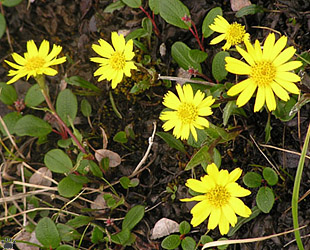|
From a rearranged translation of Vladimir
Dinets original pages to norwegian,
with supplements.

Klikk på flagg for norsk versjon

Iskaten Range, Chukotka, Russia.
|
Mountain ranges cover most of Chukotka. Although
the highest peaks only reach 1200-1800 m, these extensive,
frigid highlands have little vegetation except in lower parts f the
slopes, and are seldom visited by people.
|
|
|
|
On
the summit of Dionisia Mt.
|
The foothills, however, are full of life. Wildflower blooms here
are among the best in the Arctic, and there's a lot of wildlife

Primula, Primula sp., Dionisia Mt. |

Ledge stonecrop , Rhodiola integrifolia, Dionisia Mt. |
Primula is a genus of 400–500
species of low-growing herbs in the family Primulaceae.
They include primrose,
auricula, cowslip and oxlip. Many species are grown for their
ornamental flowers. They are native to the temperate
Northern Hemisphere, south into tropical mountains in Ethiopia,
Indonesia and New Guinea, and in temperate
southern South America.
Perennial primulas bloom mostly during the spring; their flowers
can be purple, yellow, red, pink, or white.
Generally, they prefer filtered sunlight. Many species are adapted
to alpine climates.
The word primula is the Latin feminine diminutive of primus,
meaning first (prime), applied to flowers that are among
the first to open in spring.
Primroses are used as food plants by the larvae (caterpillars)
of some Lepidoptera species, including
Duke of Burgundy butterfly, Large Yellow Underwing, Lesser Broad-bordered
Yellow Underwing,
Setaceous Hebrew Character and Silver-ground Carpet.
Source: http://en.wikipedia.org/wiki/Primula
Rhodiola
integrifolia is a species of flowering plant in the
stonecrop family known by the common names western
roseroot, king's crown, and ledge stonecrop. It is native to
Eurasia and western North America, where it grows in
mountainous habitat in subalpine and alpine climates, including
meadows, cliffs, and talus. It is a perennial herb
producing a stout stem from a fleshy, branching caudex, reaching
a maximum height near 30 centimeters.
The fleshy leaves are alternately arranged on the stem, widely
lance-shaped to oval and pointed, flat but upcurved
toward the tip, reaching 2.5 centimeters long. They are green
when new and age to orange, rose, or red.
The inflorescence is a dense cyme of up to 50 flowers with fleshy
petals in shades of bright red to deep purple. |
|
|
|
|
Foothills
of Iskaten Range near Egvenkinot.
|
Winter storms fill valleys with deep snow that takes a long time
to melt, so summer doesn't come here until July

Snow arnica, Arnica frigida, Iskaten Range. |

Northern arnica, Arnica latifolia, Iskaten Range. |
Arnica is a genus with about 30 perennial,
herbaceous species, belonging to the sunflower family, Asteraceae.
The genus name Arnica may be derived from the Greek arna,
"lamb", in reference to the soft, hairy leaves.
This circumboreal and montane (sub-alpine) genus occurs mostly
in the temperate regions of western North
America, while two are native to Eurasia (Arnica. angustifolia
and Arnica montana). |
 Iskaten
Range.
Iskaten
Range.
|

Great knot, chick,
Calidris tenuirostris,
Iultin. |
Plants and animals of the mountains are different from
lowland tundras, although most montane species
sometimes descend to dry, rocky habitats near the sea
level. Rock
ptarmigan, Lagopus mutus, replaces
willow ptarmigan, Lagopus. lagopus, at higher elevations,
but there's a lot of overlap.
A few waders, such as
great knot (left), and silver voles, Alticola macrotis,
prefer mountains to valleys.
. |

Rock ptarmigan chick,
Ichuveem Range |
|
|
|
|
Highlands
of Golden Ridge (left) and Dionisia Mt.
|
Endless talus slopes and rocky outcrops above 500 m also have some
wildlife, but it is very difficult to find.

Peregrine falcon, Falco peregrinus, nest, Dionisia Mt. |
|
The rarest creatures of high mountains are the snow sheep. They
inhabit remote ridges and cliffs,
but sometimes descend to Alpine meadows. Only a few hundred are left
on Chukotka
 Golden
Ridge.
Golden
Ridge.
|
Chukotka is one of the few places in Russia where brown
bear numbers haven't been severely depleted
by poaching for gall bladder and trophy hunting.

Brown bear, Ursus arctos, Iskaten Range |

Brown bear tracks, Belyaka Spit |
|
|
|
|
Brown
bears, Iskaten Range.
|
In summer, the bear prefer foothills near snow fields and coastal
spits. Most are very light- colored.

Brown
bear, Iskaten Range. |

Brown
bear, Iskaten Range.. |
|
|
|
|
Mountain
lake, Iskaten Range.
|
Hundreds of beautiful lakes are hidden in the mountains. Some have
endemic fish species and even genera.

Mountain
lake, Iskaten Range. |

Iskaten Range. |

View
from Golden Range, Chukotka, Russia. |
Back to
part 6
All
pictures, unless otherwise stated, Copyright © Vladimir
Dinets
|







































